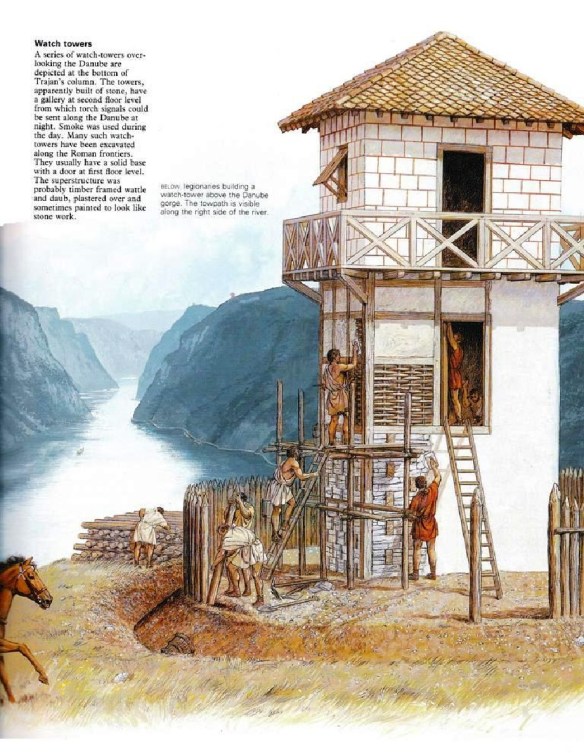There is no real consensus as to what such monumental linear boundaries as the walls in northern Britain or between the Rhine and Danube in Germany were for and how they functioned. Almost as puzzling are cases where Roman soldiers were distributed in very small detachments, often less than ten men, manning watchtowers, constructed in lines following roads or along ridges. Such deployments seem to make little sense if the primary aim of the Roman army was to defend the provinces since any serious attack would surely have overwhelmed these weak defences.
Neither the view of the Roman Empire during the Principate as essentially defensive, nor the view that it was aggressive and still hoping to expand, explains properly what the army was actually doing. Mattern has recently suggested that the defensive-offensive distinction is anachronistic, and that we should view Roman foreign relations more in terms of concepts of honour and power. The theme of her book was essentially the ideology of empire, and it did not really explain how the army operated or whether or not its activities were effective. The shift in emphasis was very useful, for it is important to understand how the Romans conceived of their relations with other peoples, and it is within this framework that we should attempt to understand what their armed forces were actually doing.
For all the insights generated by this debate, the question remains of whether or not the Romans developed something which could reasonably be described as grand strategy. As with so many labels, there is a tendency for each contributor in the debate to provide his own definition for this term, making it easier to prove that the Romans either did or did not have one. The term was created in the twentieth century, and most of the definitions employed by modern strategic literature assume the existence of institutions and ideas utterly alien to the Roman Empire. For most modern states the ideal of international affairs is peaceful coexistence with their neighbours. Each state is considered to have a right to govern itself in its own way and by its own laws. In the modern world war is the anomaly, shattering the natural state of peace. For many societies in the ancient world the reverse was true, and peace was an interruption of the normal international hostility. The Romans were inclined to think of peace as the product of an enemy’s utter defeat, hence the verb `to pacify’ (pacare) was a euphemism for `to defeat’.
Peaceful coexistence with other nations, and most of all former enemies, was never a Roman aspiration. In some way we must relate our understanding of Roman ideology to the reality of military deployment in the frontier zones, many areas of which were constantly occupied for centuries on end. It is therefore worth considering the army’s deployment in these areas and trying to reconstruct what it was doing. In doing so we must try to look at the fringes of the Roman Empire from both directions.
Raiding does appear to have been endemic in the tribal societies of Spain, Britain, Gaul, Germany, Thrace, Illyria and Africa. Caesar claimed that the Helvetii migrated to occupy lands which would give them more opportunity to raid their neighbours (B Gall. 1.2).We are told that German tribes tried to keep a strip of depopulated land around their borders as a protection against enemy raids. This was also a measure of a tribe’s martial prowess and thus a deterrent to attacks. The Belgian tribes grew thick thorn hedges as boundary markers that were intended to delay raiding groups. They may also have been a sign that crossing them would be met with force, and it was probably no coincidence that Caesar’s army had to fight a battle at the Sambre soon after passing such a barrier (B Gall. 2.17, 6.23). The archaeological record of weapons burials in many regions of Europe confirms a picture of societies in which martial symbols were very important, and it is implausible to suggest that many Celtic tribes were not warlike warrior societies.
Our sources inevitably only report raids carried out on a large scale, usually by thousands of warriors. Only well-established leaders in reasonably united tribes could ever have mustered such forces. The warriors in many societies were strongly independent, choosing whether or not to join a leader who proclaimed that he was to lead a raid. Most raiding bands were probably much smaller. Even Ammianus, who provides far more detailed accounts of activities in the frontier provinces than any earlier source, never specifically mentions groups of fewer than 400 marauders. The distribution of Roman troops in penny packets to man lines of watchtowers might make a lot more sense if they were facing raids by equally small or smaller groups of warriors. The distinction between warfare and banditry blurs at this level, but there are many hints that small-scale violence was common in the empire.
